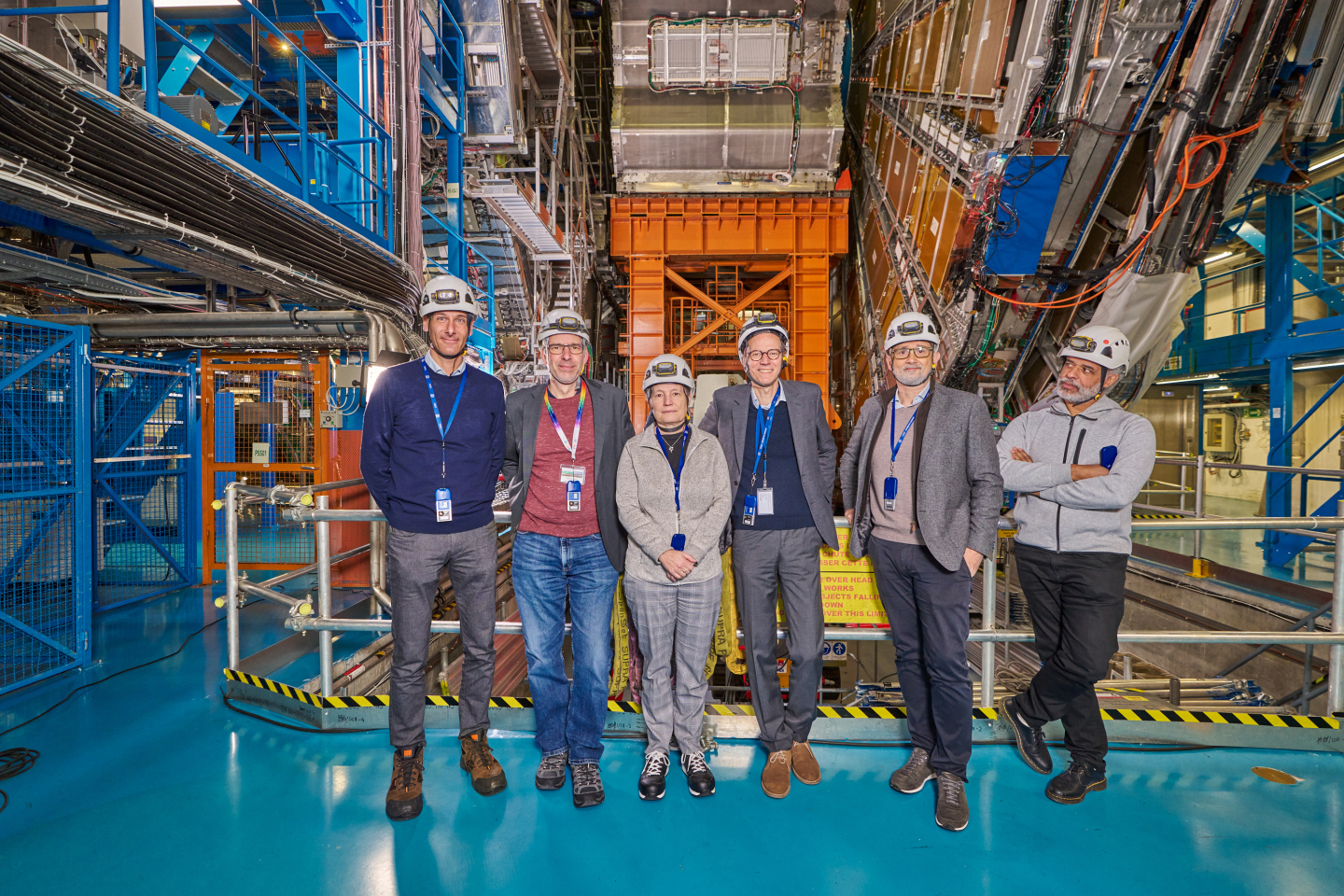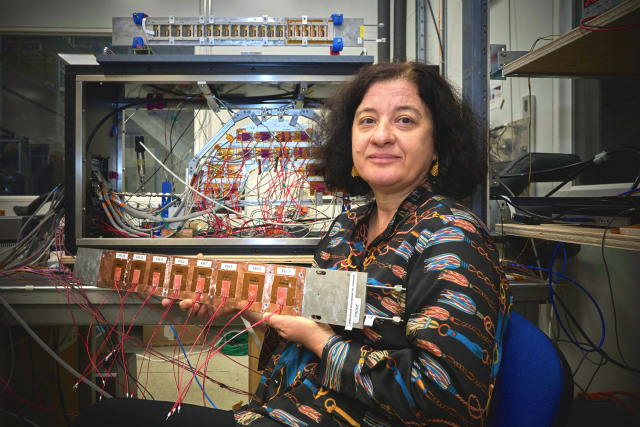From internship to authorship: one student’s unique journey in ATLAS
30 October 2023 | By

I am Lukas Kretschmann, 19 years old, and I have a profound passion for physics. I am currently a physics student at the University of Wuppertal in Germany, and am actively engaged in its experimental particle physics group. My fascination with this field began during my high school years when I first dived into the world of particle physics during an internship at the University of Wuppertal. This journey led me to initiate a personal research project, delving into ATLAS open data, under the guidance of an experienced physicist from the group.
A year before graduating from high school, my project supervisor asked me if I was interested in calculating cross-sections for their ATLAS physics analysis using the program I had utilised in my personal project. That was when I officially joined the ATLAS team of the University of Wuppertal, ready to contribute my enthusiasm and skills to their quest to unravel the secrets of the universe.
In addition to my research, I was actively involved in events organised by "Netzwerk Teilchenwelt" (NTW), an outstanding German organisation dedicated to fostering curiosity about fundamental science, with a particular emphasis on particle physics. The network offers an exceptional fellowship programme for young particle-physics enthusiasts, combining online events and in-person courses to foster a sense of collective learning. Interacting with like-minded students during these gatherings has always been a delight. Through my involvement with NTW, my knowledge in the field expanded significantly, but even more enriching were the many friendly faces I encountered along the way, some of whom have become my dearest friends. Thanks to NTW, I had the incredible opportunity to visit CERN for the first time, a pivotal experience in my scientific journey. Since 2022, I have been honoured to serve as a national speaker for the fellow programme, sharing this role with a student from Dresden University, which allows me to contribute to the growth and impact of the programme.
Upon joining ATLAS, I began attending Collaboration meetings, presenting my work, and actively participating in ATLAS outreach efforts. These experiences provided me with a wealth of knowledge, especially from those heavily involved in outreach activities, which fuelled my desire to give back to the community.
During my first year as a Bachelor's student, I developed a deep appreciation for the welcoming and supportive nature of the ATLAS team at the University of Wuppertal. Despite being a junior member, I felt integrated with the team. Our collaborative spirit extended beyond the lab, featuring various social activities, including monthly foosball tournaments and adventurous water-skiing outings. These enjoyable moments underscored the essence of research as not merely an office-bound endeavour but a vibrant tapestry of collaboration and camaraderie. I look forward to going to the office every morning not just because of the exciting work, but also for the friendly atmosphere. They offer a support system during challenging times and are a network of like-minded individuals, which make each day a fulfilling experience. I'm truly thankful for the warmth and support that our group provides, especially from our dedicated supervisor. The atmosphere is welcoming and supportive, as evidenced by their unwavering support for my unique early-career trajectory.
As part of my role within the group, I work on cross-section calculations for a single top-quark t-channel analysis, and the results are used as the recommended reference cross-sections of the LHC top-quark Working Group. One remarkable aspect of working in the ATLAS Collaboration is that, though I am not yet an official ATLAS author (i.e. one of the 3000 physicists who co-sign the research released by the Collaboration), my valuable work can earn me exceptional authorship for specific ATLAS publications.
It was a heartwarming atmosphere that underscored the sense of belonging to a larger team dedicated to the precise operation of the detector.
Soon after acquiring exceptional authorship for the t-channel paper, I embarked on my qualification task to become an official ATLAS author. This task is a technically demanding project supervised by an expert and requires a minimum commitment of six months. My project involved enhancing the configuration of one of the Monte Carlo generators. I submitted regular progress reports, which culminated in comprehensive documentation of the work and outlined avenues for further development. I am on the cusp of completing my ATLAS qualification task, and eagerly anticipating becoming the youngest author in the ATLAS Collaboration.
Like many members of the ATLAS Collaboration, I’ve been able to participate in the operation of the ATLAS detector and work in the ATLAS control room at CERN. But before the work could begin, I first had to complete a structured training regimen. I participated in a two-day training programme designed to provide a comprehensive understanding of the general aspects of detector operation. This was followed by specialised training for specific control room desks. Each subsystem of ATLAS has its designated desk within the control room, focusing on the watchful monitoring of the detectors. In my case, I followed a training course for the Inner Detector desk (ID).

After completing this final course (online), I signed up for shifts and arranged my journey to CERN. Before taking responsibility for my shifts, I shadowed experienced colleagues and learned from their guidance. After a week of shadowing, I was ready to embark on my first shift at the ID desk. On my second-ever shift, an exciting moment unfolded as the LHC injected lead ions, marking the first stable-beam collisions of such ions in half a decade. The control room buzzed with activity, becoming increasingly crowded as the anticipation grew following the LHC's announcement of the forthcoming stable-beam collisions.
As they commenced the complex process of ramping up the beam energy, I could not help but feel a degree of stress, given that it was only my second shift. Through collective efforts and the guidance of many experts in the control room, we successfully readied the ID systems to record invaluable ion-collision data. The dedicated shift crew, including myself, worked diligently to keep the ID detector operational and gather as much data as possible.
The momentous occasion came when the beams finally collided, the room erupted in applause and cheers. We all gathered to see the first heavy-ion collision event display projected at the front of the control room. A joyous celebration followed, complete with champagne and snacks. It was a heartwarming atmosphere that underscored the sense of belonging to a larger team dedicated to the precise operation of the detector and the entire ATLAS Collaboration. We all shared the common goal of collecting enough data for in-depth analysis, a stark reminder of the colossal effort required in this scientific endeavour.
After my final shift, I held reserve shifts for emergencies and then prepared to travel back to Germany. I plan to return, possibly for shifts, during the LHC's 2024 operations. In the interim, I will continue my studies at the University of Wuppertal and contribute to our group's ongoing research. There are already follow-up analyses to the t-channel analysis I previously worked on, promising a host of interesting and challenging tasks to occupy me upon my return.




